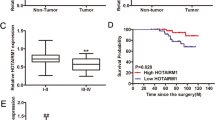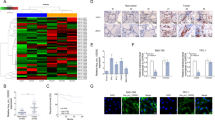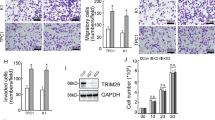Abstract
MicroRNAs (miRNAs) are thought to control tumor metastasis through direct interactions with target genes. Thyroid hormone (T3) and its receptor (TR) are involved in cell growth and cancer progression. However, the issue of whether miRNAs participate in T3/TR-mediated tumor migration is yet to be established. In the current study, we demonstrated that T3/TR negatively regulates mature miR-17 transcript expression, both in vitro and in vivo. Luciferase reporter and chromatin immunoprecipitation (ChIP) assays localized the regions responding to TR-mediated repression to positions −2234/−2000 of the miR-17 promoter sequence. Overexpression of miR-17 markedly inhibited cell migration and invasion in vitro and in vivo, mediated via suppression of matrix metalloproteinases (MMP)-3. Moreover, p-AKT expression was increased in miR-17-knockdown cells that led to enhanced cell invasion, which was blocked by LY294002. Notably, low miR-17 expression was evident in highly metastatic cells. The cell migration ability was increased by T3, but partially reduced upon miR-17 overexpression. Notably, TRα1 was frequently upregulated in hepatocellular carcinoma (HCC) samples and associated with low overall survival (P=0.023). miR-17 expression was significantly negatively associated with TRα1 (P=0.033) and MMP3 (P=0.043) in HCC specimens. Data from our study suggest that T3/TR, miR-17, p-AKT and MMP3 activities are interlinked in the regulation of cancer cell metastasis.
This is a preview of subscription content, access via your institution
Access options
Subscribe to this journal
Receive 50 print issues and online access
$259.00 per year
only $5.18 per issue
Buy this article
- Purchase on Springer Link
- Instant access to full article PDF
Prices may be subject to local taxes which are calculated during checkout






Similar content being viewed by others
References
Huang YH, Tsai MM, Lin KH . Thyroid hormone dependent regulation of target genes and their physiological significance. Chang Gung Med J 2008; 31: 325–334.
Yen PM . Physiological and molecular basis of thyroid hormone action. Physiol Rev 2001; 81: 1097–1142.
Cheng SY . Multiple mechanisms for regulation of the transcriptional activity of thyroid hormone receptors. Rev Endocr Metab Disord 2000; 1: 9–18.
Thormeyer D, Baniahmad A . The v-erbA oncogene (review). Int J Mol Med 1999; 4: 351–358.
Barrera-Hernandez G, Park KS, Dace A, Zhan Q, Cheng SY . Thyroid hormone-induced cell proliferation in GC cells is mediated by changes in G1 cyclin/cyclin-dependent kinase levels and activity. Endocrinology 1999; 140: 5267–5274.
Hall LC, Salazar EP, Kane SR, Liu N . Effects of thyroid hormones on human breast cancer cell proliferation. J Steroid Biochem Mol Biol 2008; 109: 57–66.
Tsui KH, Hsieh WC, Lin MH, Chang PL, Juang HH . Triiodothyronine modulates cell proliferation of human prostatic carcinoma cells by downregulation of the B-cell translocation gene 2. Prostate 2008; 68: 610–619.
Davis FB, Tang HY, Shih A, Keating T, Lansing L, Hercbergs A et al. Acting via a cell surface receptor, thyroid hormone is a growth factor for glioma cells. Cancer Res 2006; 66: 7270–7275.
Lai EC . Micro RNAs are complementary to 3′ UTR sequence motifs that mediate negative post-transcriptional regulation. Nat Genet 2002; 30: 363–364.
Tsang YS, Lo KW, Leung SF, Choi PH, Fong Y, Lee JC et al. Two distinct regions of deletion on chromosome 13q in primary nasopharyngeal carcinoma. Int J Cancer 1999; 83: 305–308.
Calin GA, Dumitru CD, Shimizu M, Bichi R, Zupo S, Noch E et al. Frequent deletions and down-regulation of micro- RNA genes miR15 and miR16 at 13q14 in chronic lymphocytic leukemia. Proc Natl Acad Sci USA 2002; 99: 15524–15529.
Calin GA, Sevignani C, Dumitru CD, Hyslop T, Noch E, Yendamuri S et al. Human microRNA genes are frequently located at fragile sites and genomic regions involved in cancers. Proc Natl Acad Sci USA 2004; 101: 2999–3004.
Lin YW, Sheu JC, Liu LY, Chen CH, Lee HS, Huang GT et al. Loss of heterozygosity at chromosome 13q in hepatocellular carcinoma: identification of three independent regions. Eur J Cancer 1999; 35: 1730–1734.
Muller D, Breathnach R, Engelmann A, Millon R, Bronner G, Flesch H et al. Expression of collagenase-related metalloproteinase genes in human lung or head and neck tumours. Int J Cancer 1991; 48: 550–556.
Nomura H, Fujimoto N, Seiki M, Mai M, Okada Y . Enhanced production of matrix metalloproteinases and activation of matrix metalloproteinase 2 (gelatinase A) in human gastric carcinomas. Int J Cancer 1996; 69: 9–16.
Bramhall SR, Stamp GW, Dunn J, Lemoine NR, Neoptolemos JP . Expression of collagenase (MMP2), stromelysin (MMP3) and tissue inhibitor of the metalloproteinases (TIMP1) in pancreatic and ampullary disease. Br J Cancer 1996; 73: 972–978.
Okamoto K, Ishida C, Ikebuchi Y, Mandai M, Mimura K, Murawaki Y et al. The genotypes of IL-1 beta and MMP-3 are associated with the prognosis of HCV-related hepatocellular carcinoma. Intern Med 2010; 49: 887–895.
Lin KH, Shieh HY, Hsu HC . Negative regulation of the antimetastatic gene Nm23-H1 by thyroid hormone receptors. Endocrinology 2000; 141: 2540–2547.
Nakano K, Matsushita A, Sasaki S, Misawa H, Nishiyama K, Kashiwabara Y et al. Thyroid-hormone-dependent negative regulation of thyrotropin beta gene by thyroid hormone receptors: study with a new experimental system using CV1 cells. Biochem J 2004; 378 (Pt 2): 549–557.
Chi HC, Chen SL, Liao CJ, Liao CH, Tsai MM, Lin YH et al. Thyroid hormone receptors promote metastasis of human hepatoma cells via regulation of TRAIL. Cell Death Differ 2012; 19: 1802–1814.
Chen RN, Huang YH, Lin YC, Yeh CT, Liang Y, Chen SL et al. Thyroid hormone promotes cell invasion through activation of furin expression in human hepatoma cell lines. Endocrinology 2008; 149: 3817–3831.
Shan SW, Lee DY, Deng Z, Shatseva T, Jeyapalan Z, Du WW et al. MicroRNA MiR-17 retards tissue growth and represses fibronectin expression. Nat Cell Biol 2009; 11: 1031–1038.
Li H, Bian C, Liao L, Li J, Zhao RC . miR-17-5p promotes human breast cancer cell migration and invasion through suppression of HBP1. Breast Cancer Res Treat 2011; 126: 565–575.
Yu Z, Wang C, Wang M, Li Z, Casimiro MC, Liu M et al. A cyclin D1/microRNA 17/20 regulatory feedback loop in control of breast cancer cell proliferation. J Cell Biol 2008; 182: 509–517.
Yu Z, Willmarth NE, Zhou J, Katiyar S, Wang M, Liu Y et al. microRNA 17/20 inhibits cellular invasion and tumor metastasis in breast cancer by heterotypic signaling. Proc Natl Acad Sci USA 2010; 107: 8231–8236.
Yang F, Yin Y, Wang F, Wang Y, Zhang L, Tang Y et al. miR-17-5p Promotes migration of human hepatocellular carcinoma cells through the p38 mitogen-activated protein kinase-heat shock protein 27 pathway. Hepatology 2010; 51: 1614–1623.
Chang CC, Yang YJ, Li YJ, Chen ST, Lin BR, Wu TS et al. MicroRNA-17/20a functions to inhibit cell migration and can be used a prognostic marker in oral squamous cell carcinoma. Oral Oncol 2013; S1040-8428: 00070–0007.
Zhang M, Dai C, Zhu H, Chen S, Wu Y, Li Q et al. Cyclophilin A promotes human hepatocellular carcinoma cell metastasis via regulation of MMP3 and MMP9. Mol Cell Biochem 2011; 357: 387–395.
Sze KM, Wong KL, Chu GK, Lee JM, Yau TO, Ng IO . Loss of phosphatase and tensin homolog enhances cell invasion and migration through AKT/Sp-1 transcription factor/matrix metalloproteinase 2 activation in hepatocellular carcinoma and has clinicopathologic significance. Hepatology 2011; 53: 1558–1569.
Wu SM, Huang YH, Yeh CT, Tsai MM, Liao CH, Cheng WL et al. Cathepsin H regulated by the thyroid hormone receptors associate with tumor invasion in human hepatoma cells. Oncogene 2011; 30: 2057–2069.
Chen CY, Chi LM, Chi HC, Tsai MM, Tsai CY, Tseng YH et al. Stable isotope labeling with amino acids in cell culture (SILAC)-based quantitative proteomics study of a thyroid hormone-regulated secretome in human hepatoma cells. Mol Cell Proteomics 2012; 11: M111 011270.
Kress E, Skah S, Sirakov M, Nadjar J, Gadot N, Scoazec JY et al. Cooperation between the thyroid hormone receptor TRalpha1 and the WNT pathway in the induction of intestinal tumorigenesis. Gastroenterology 2010; 138: 1863–1874.
Samuels HH, Stanley F, Casanova J . Depletion of L-3,5,3'-triiodothyronine and L-thyroxine in euthyroid calf serum for use in cell culture studies of the action of thyroid hormone. Endocrinology 1979; 105: 80–85.
Xu C, Liu S, Fu H, Li S, Tie Y, Zhu J et al. MicroRNA-193b regulates proliferation, migration and invasion in human hepatocellular carcinoma cells. Eur J Cancer 2010; 46: 2828–2836.
Liao CH, Yeh SC, Huang YH, Chen RN, Tsai MM, Chen WJ et al. Positive regulation of spondin 2 by thyroid hormone is associated with cell migration and invasion. Endocr Relat Cancer 2010; 17: 99–111.
Liao CJ, Wu TI, Huang YH, Chang TC, Wang CS, Tsai MM et al. Glucose-regulated protein 58 modulates cell invasiveness and serves as a prognostic marker for cervical cancer. Cancer Sci 2011; 102: 2255–2263.
Huang YH, Liao CH, Chen RN, Liao CJ, Lin KH . Human testicular orphan receptor 4 enhances thyroid hormone receptor signaling. J Cell Physiol 2010; 222: 347–356.
Lin YH, Huang YH, Wu MH, Wu SM, Chi HC, Liao CJ et al. Thyroid hormone suppresses cell proliferation through endoglin-mediated promotion of p21 stability. Oncogene 2013; 32: 3904–3914.
Acknowledgements
This work was supported by grants from Chang-Gung University, Taoyuan, Taiwan (CMRPD 34013, NMRP 140511) and from the National Science Council of the Republic of China (NSC 94-2320-B-182-052, NSC 98-2312-B-182A-001-MY3).
Author information
Authors and Affiliations
Corresponding author
Ethics declarations
Competing interests
The authors declare no conflict of interest.
Additional information
Supplementary Information accompanies this paper on the Oncogene website
Supplementary information
Rights and permissions
About this article
Cite this article
Lin, YH., Liao, CJ., Huang, YH. et al. Thyroid hormone receptor represses miR-17 expression to enhance tumor metastasis in human hepatoma cells. Oncogene 32, 4509–4518 (2013). https://doi.org/10.1038/onc.2013.309
Received:
Accepted:
Published:
Issue Date:
DOI: https://doi.org/10.1038/onc.2013.309
Keywords
This article is cited by
-
Hypomethylation of Thyroid Peroxidase as a Biomarker for Hepatocellular Carcinoma with Tumor Thrombosis
Current Medical Science (2022)
-
Low thyroid hormone receptor alpha-2 (THRα-2) tumor expression is associated with unfavorable tumor characteristics and high breast cancer mortality
Breast Cancer Research (2021)
-
Non-coding RNAs in hepatocellular carcinoma: molecular functions and pathological implications
Nature Reviews Gastroenterology & Hepatology (2018)
-
Differential Maturation of miR-17 ~ 92 Cluster Members in Human Cancer Cell Lines
Applied Biochemistry and Biotechnology (2017)
-
Pleiotropic functions of the tumor- and metastasis-suppressing matrix metalloproteinase-8 in mammary cancer in MMTV-PyMT transgenic mice
Breast Cancer Research (2015)



